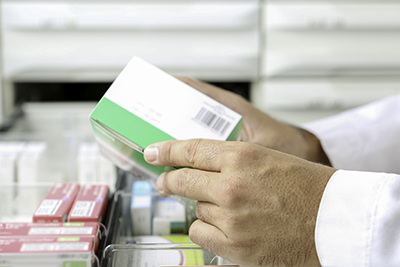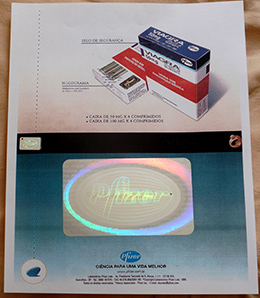Drug Packaging | Holography Gets in on the Act
- Published: November 07, 2017, By Manoj Kochar
November 2017 saw a requirement to print a unique product identification code on prescription drug units of sale and homogeneous cases distributed in the US. The chairman of the International Hologram Mfrs. Assn. argues that a product identifier initiative by itself cannot be considered an authentication solution under ISO 12931.
 Regulation is currently driving concerns for those involved in pharmaceutical manufacturing, production, and distribution with governments, national agencies, and those with responsibility for law enforcement moving to protect the sector from criminals and counterfeiters through legislation such as the Drug Supply Chain Security Act (DSCSA).
Regulation is currently driving concerns for those involved in pharmaceutical manufacturing, production, and distribution with governments, national agencies, and those with responsibility for law enforcement moving to protect the sector from criminals and counterfeiters through legislation such as the Drug Supply Chain Security Act (DSCSA).
Some requirements began in November 2014 and several key requirements began at various stages in 2015. The new requirements, development of standards, and the system for product tracing will continue to be phased in until 2023, while the FDA will remain committed to working with trading partners and other stakeholders to effectively implement the new requirements.
However, the next milestone is Nov. 27, 2017, by which date pharmaceutical manufacturers will be required to print a unique product identification code on all prescription drug units of sale and homogeneous cases distributed in the USA. The move comes against a backdrop of a seemingly relentless rise in the counterfeiting, illicit supply, or falsification of pharmaceutical products, which in turn impacts on brand values, market capitalization and supplier reputation.
In Europe, the problem is estimated to cost €10bn annually¹, while in the States, the piracy and counterfeiting of drugs cost businesses more than $200 billion annually and accounts for the loss of more than 750,000 jobs².
Globally, it’s almost impossible to measure the full impact of the problem or count the cost, but some estimates say that counterfeiting is costing the world’s pharmaceutical companies several hundreds of billions of dollars annually. And the problem is only set to continue in the face of continued globalization and ever-extending supply chains.
The Drug Quality and Security Act (DQSA3), was signed into law by President Barack Obama on Nov. 27, 2013. Title II of the DQSA, the Drug Supply Chain Security Act, outlines critical steps to build an electronic, interoperable system to identify and trace certain prescription drugs as they are distributed in the United States. The system is designed to facilitate the exchange of information at the individual package level about where a drug has been in the supply chain and will enable verification of the legitimacy of the drug product identifier down to the package level. It will also enhance detection and notification of illegitimate products in the drug supply chain while facilitating more efficient recalls of drug products.

Drug manufacturers, wholesale drug distributors, re-packagers, and many dispensers (primarily pharmacies) will be called on to work in cooperation with FDA to develop this new system over the next 10 years, with key provisions to be implemented covering requirements for product identification, product tracing, product verification, detection and response, notification, wholesaler licensing, and third-party logistics provider licensing.
The move will enhance the U.S. Food and Drug Administration’s ability to help protect consumers from exposure to drugs that may be counterfeit, stolen, contaminated, or otherwise harmful, improving the detection and removal of potentially dangerous drugs from the supply chain to protect consumers. Failure to comply with the requirements of the law can result in penalties while the development of the system is phased in with new requirements that will include providing product and transaction information at each sale, in paper or electronic format, and placing unique product identifiers on individual drug packages.
Furthermore, Chapter III: The Identification of Suspect Product and, for manufacturers, product with a high risk of illegitimacy includes a clause — Appearance of the Product — provides guidelines recommending that heightened vigilance is appropriate in the following instance (among others) … Package that is missing security or anti-counterfeiting technologies normally featured on the FDA-approved product that are easily visible to the eye, such as holograms, color shifting inks, neckbands, or watermarks.
ISO 12931: Raising the standard
Counterfeiting is being driven by many factors: increased industrialization, advanced printing and reproduction technologies, the impact of the internet, vulnerable supply chains, the power of consumerism, ineffectual law enforcement, and lenient criminal penalties among others. And while the U.S. will always be in the crosshairs of the counterfeiters, it’s in the new economic powerhouses where the counterfeiting of and illicit traffic in all kinds of pharmaceuticals, medicines, and drugs has become most prevalent and brand sanctity faces some of its biggest threats.
ISO 12931 talks about the "Performance criteria for authentication solutions used to combat counterfeiting of material goods…" i.e., specifying performance criteria and evaluation methodology for authentication solutions, but track and trace technology by itself is not a security solution. However, in conjunction with an optically variable device (OVD) such as a hologram, it can become a potent value added security solution.
about the "Performance criteria for authentication solutions used to combat counterfeiting of material goods…" i.e., specifying performance criteria and evaluation methodology for authentication solutions, but track and trace technology by itself is not a security solution. However, in conjunction with an optically variable device (OVD) such as a hologram, it can become a potent value added security solution.
The identity of individual items can be linked to packaging through a unique code, which in turn can be linked to case ID, pallet ID, or container ID. The recording of this so-called parent/child relationship between unit pack, carton, and pallet is the beginning of an electronic pedigree that allows the item to be tracked and monitored throughout the supply chain: from the production line and packaging through distribution channels to the final end-user. This type of usage also can be used to capture important events in a product’s life cycle – for instance, quality assurance rejects and product returns – creating a flexible database, which offers a unique product history and other business recording benefits.
So why does this matter? The DSQA will become law (and certain to be welcome in many quarters as a valuable weapon in the war on counterfeiting), so it must be considered a highly significant and important move, which cannot be ignored. It is aimed at addressing the supply and distribution of illegal or counterfeit products and is set to have an impact on manufacturers, co-packers, and wholesalers who will need to comply with the track and trace, UDI. and validation requirements. Moreover, it highlights the importance of using an optical security feature such as a hologram over and above serialization.
The view of the International Hologram Mfrs. Assn. (IHMA) and wider industry is that a product identifier initiative by itself cannot be considered an authentication solution under ISO 12931. However, optical security technology has advanced to such a position that when its integrated with track and trace it can provide manufacturers with the tools to be fully compliant with the forthcoming legislation — incorporating beneficial features that can help users generate unique sequential, encrypted or random serial numbers, or identify and mark products overtly or covertly either via special self-adhesive labels or directly onto pharmaceutical products using a variety of print technologies.
The technology’s capacity to incorporate other data forms and product tracking information will become increasingly important as technology pushes forward and the nature of anti-counterfeiting changes with the times. This enables holograms to be used for a widening range of pharmaceutical authentication and brand protection roles, linking on-pack product identification with supply chain management, market enforcement, and forensic support services.
In this way, the identity and distribution of goods can be controlled through a total system solution involving security authentication features, tracking mechanisms, and investigative services.
Of notable value to the brand owner (and a strong financial incentive to make the investment in such systems) is the fact that the information generated at the labeling stage can be linked to the company’s ERP (enterprise resource planning) system; enabling business functions such as manufacturing, supply chain management, finance, projects, HR, and customer relationship management to be captured and better managed.
Integration
The move toward outsourcing the production of pharmaceutical products might be beneficial in terms of reducing manufacturing costs, but it also can impact upon the control of brand security and visibility. Here holograms can be integrated into the supply chain security process to allow companies to maintain control of their products — from the sourcing of labels or proprietary components to the manufacturing and shipment of finished goods.
Holograms can also be integrated with secure web interfaces to help eliminate rogue ordering of products while authorized distributors can pick, pack, and ship items in carefully measured quantities to customers, with the product’s movements throughout the supply chain, fully tracked and documented. And it is important to encourage the brand owners to take the necessary steps to create awareness about holograms — and their multifarious applications and benefits — to fully unleash their potential.
ABOUT THE AUTHOR
Manoj Kochar is chairman of the International Hologram Mfrs. Assn., Sunbury, U.K., which is made up of 100 of the world's leading hologram companies and includes producers and converters of holograms for banknote security, anti-counterfeiting, brand protection, packaging, graphics, and other commercial applications around the world. Members actively cooperate to maintain the highest professional, security, and quality standards. Its responsibilities cover the Hologram Image Register, a centrally held database that provides faster online registration and copyright checking of hologram designs. Operated under the strictest confidence and security, manufacturers and producers can register their holograms, enabling them to check that production designs do not inadvertently copy existing ones and infringe copyright. Registration is a fully online process that sees artwork submitted electronically providing quicker design checks. It is also faster as no hard copy forms are required while internet access via a secure portal provides improved ease-of-use.
1. https://euipo.europa.eu/ohimportal/en/web/observatory/ipr-infringement-pharmaceutical-sector)
2. https://www.ncbi.nlm.nih.gov
3. https://www.fda.gov/Drugs/DrugSafety/DrugIntegrityandSupplyChainSecurity/DrugSupplyChainSecurityAct/












